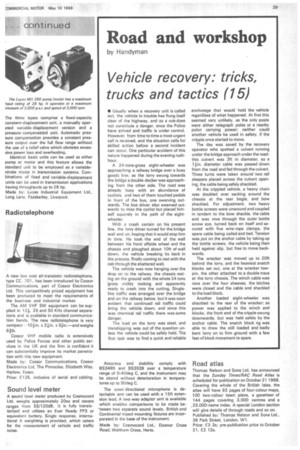Road and workshop
Page 41

If you've noticed an error in this article please click here to report it so we can fix it.
Vehicle recovery: tricks, trucks and tactics (15)
by Handyman
• Usually when a recovery unit is called out, the vehicle in trouble has flung itself clear of the highway, and as a rule does not constitute a danger, once the Police have arrived and traffic is under control. However, from time to time a most urgent call is received, and the situation calls for skilled action before a second incident can occur. One particular accident of this nature happened during the evening rushhour.
A 24-tons-gross eight-wheeler was approaching a railway bridge over a busy goods line; as the lorry swung towards the bridge a double-decker was approaching from the other side. The road was already busy with an abundance of cyclists, and two of them touched pedals in front of the bus, one swerving outwards. The bus driver also swerved outwards to miss the cyclist but placed himself squarely in the path of the eightwheeler.
With a crash certain on his present line, the lorry driver turned for the bridge • wall end on, hoping that it would stop him in time. He took -the end of the wall between his front offside wheel and the chassis and ploughed about 10ft of wall down, the vehicle breaking its back in the process, finally coming to rest with the cab through the shattered wall.
The vehicle was now hanging over the drop on to the railway, the chassis resting on the ground with the whole 24 tons 'gross visibly rocking and apparently ready to crash into the cutting. Singleline traffic was arranged over the bridge and on the railway below, but it was soon evident that continued rail traffic could bring the vehicle down, and since this was chemical rail traffic there was some danger.
The load on the lorry was steel, and transhipping was out of the question unless the vehicle could be safely held. The first task was to find a quick and reliable anchorage that would hold the vehicle regardless of what happened. At first this seemed very unlikely, as the only posts were either telegraph poles or a nearby pylon carrying power: neither could another vehicle be used in safety, if the cripple once started to move.
The day was saved by the recovery operator who spotted a culvert running under the bridge approach under the road: this culvert was 3ft in diameter, so a llin. diameter cable was passed down from the road and fed through the culvert. Three turns were taken around two rail sleepers placed across the culvert opening, the cable being safely shackled.
At the crippled vehicle, a heavy chain was doubled over sacking around the chassis at the rear bogie, and bow shackled. For adjustment, two heavy bottle screws were unwound and coupled in tandem to the bow shackle, the cable end was rove through the outer bottle screw eye, turned back on itself and secured with five wire-rope clamps, the spare cable being coiled and tied, Tension was put on the anchor cable by taking up the bottle screws, the vehicle being then held against slip, but free to move backwards.
The wrecker was moved up to 20ft behind the lorry, and the heaviest snatch blocks set out, one at the wrecker towpin, the other attached to a double trace at the lorry chassis. The winch cable was rove over the four sheaves, the latches were closed and the cable end shackled to the load block.
Another loaded eight-wheeler was shackled to the rear of the wrecker: as power was applied to the winch and blocks, the front end of the cripple swung downwards, but was held safely by the anchor cable. The snatch block rig was able to draw the still loaded and badly bent lorry on to firm ground with a few feet of block movement to spare.












































































































